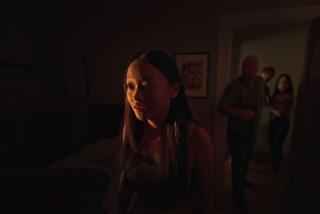Swedish Retrospective Continues at UCLA
- Share via
UCLA Film Archive and the Swedish Institute’s splendid retrospective of important but rarely seen Swedish films continues Saturday at 6 p.m. in UCLA’s Melnitz Theater with two Alf Sjoberg films, “Iris and the Lieutenant” (1946) and “Torment” (1944).
Sjoberg is known for “Torment” because it marked Ingmar Bergman’s first screenplay and for his outstanding adaptation of Strindberg’s “Miss Julie,” which took the grand prize at Cannes in 1951. However, Sjoberg, who died in 1980, has long been regarded by scholars and critics as a major director.
Both films star Mai Zetterling and the late Alf Kjellin (both of whom became directors). The well-known “Torment” is a brooding tale of young lovers beset by a sadistic professor; in the second film, they’re again star-crossed lovers. “Iris and the Lieutenant” looks and plays like a big romantic Hollywood movie of the ‘40s as it asks whether a humble but pretty servant (Zetterling) with a past can find happiness with the handsome son (Kjellin) of an immensely rich and disapproving shoe manufacturer.
The difference, of course, is in the realism: They live together without benefit of clergy, and there’s no guarantee of a happy ending. What you might not pick up via subtitles is that the film is also a comment on a patriarchal society on the verge of crumbling. Despite the dated quality of its story, “Iris and the Lieutenant” remains vibrant in its passion and honesty. (Next weekend promises more Sjoberg treasures.)
Sunday’s program offers proof of Mauritz Stiller’s astonishing versatility (which makes his failure in Hollywood all the sadder and more perplexing). In contrast to “Erotikon,” which anticipated the sophisticated comedies of Lubitsch, “The Song of the Scarlet Flower” (1919), screening at 7:30 p.m., is based on a popular--and very Victorian--tale about the redemption of a farmer’s son (Lars Hanson) cast out when he’s caught in a compromising situation with a housemaid--in spite of the fact that nothing had happened between them. It has a remarkable sequence in which Hanson balances on a log as it proceeds down a river to treacherous rapids. In theme and in this sequence, this film anticipates D.W. Griffith’s “Way Down East,” made the following year.
“Sir Arne’s Treasure,” which follows, must be Stiller’s masterpiece, a stirring and visually splendid epic tale of death and revenge and ill-fated love set in the 16th Century and based on a story by Selma Lagerlof. The luminous Mary Johnson plays a young woman tormented by a love for the man (Richard Lund) who has slain her family and stolen its treasure. The film possesses a psychological complexity unusual for its time and has some spectacularly stark sequences set on a frozen sea. It is remarkable that Stiller, a man so at home in the drawing rooms and boudoirs of “Erotikon,” would also have such a strong feeling for nature.
Preceding the two Stiller films at 5:30 is “The Prisoner of Carlsten’s Fort” (1916), a slight chase adventure indistinguishable from the short films Hollywood was grinding out at the time. Organist Robert Israel will accompany the silent films. Information: (213) 206-8013.
More to Read
Only good movies
Get the Indie Focus newsletter, Mark Olsen's weekly guide to the world of cinema.
You may occasionally receive promotional content from the Los Angeles Times.










